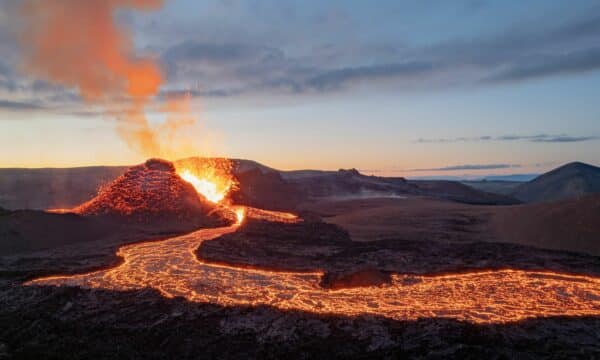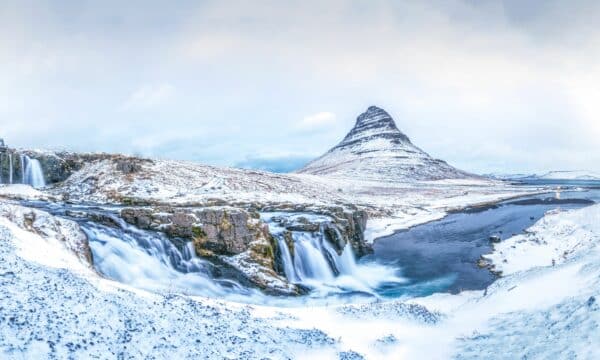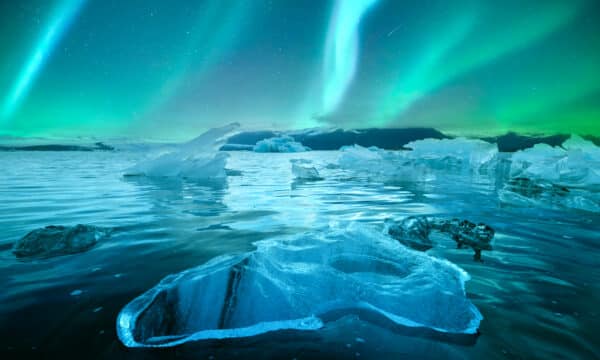- Cover photo: Mirra via Flickr
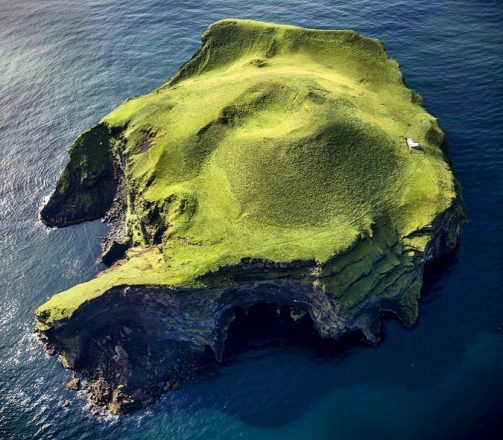
Known as ‘Vestmannaeyjar’ in Icelandic, these islands offer a variety of sights and activities for those lucky travellers who come for a visit.
Both an archipelago and an Icelandic municipality, the Westman Islands’ largest and only inhabited island, Heimaey, is home to around 4500 people.
- The Westman Islands are just off Iceland’s South Coast. Read more about South Iceland here
Around fifteen smaller islands dot its surrounding coastal waters, not mentioning the great number of rock stacks and skerries that attract countless bird species to the area each year.
In total, these islands cover 17 square kilometres (7 square miles), having first begun their formation around 10,000 to 12,000 years ago due to violent underwater eruptions.
Today, the Westman Islands enjoy something of a microclimate, seeing very little snow comparatively to the mainland, but high levels of rain and wind.
Be that as it may, such weather has only added to the hardiness and adventurous spirit of its people. In fact, the islands take their names from the Irish slaves (West Men) who were captured by roaming Norsemen during the early settlement period.
In this guide, we look to cover the top 11 things to do in the Westman Islands. Below you will find information on how to get there, as well as facts about the island’s interesting history, and even local trade-secrets, including the best spots to see charming puffins.
1. Climb Eldfell Volcano
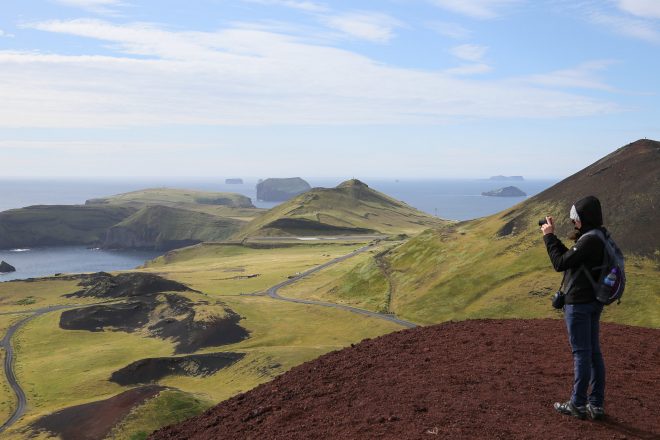
There are only a handful of places in the world where you can explore a volcano. On Vestmannaeyjar’s biggest island, Heimaey, you can explore two: Eldfell and Helgafell.
While a walk on Helgafell provides a fantastic view of Iceland’s South Coast, it is Eldfell’s dramatic history which steals the show.
After a series of weak tremors, the dormant volcano erupted suddenly on the 23rd of January 1973 at 1:55 AM local time. A 300-metre (984 ft) fissure opened up on the eastern side of the island which rapidly extended to a length of 2 kilometres (1.2 mi).
The eruption also caused a spectacular lava flow which, in some places, rose to a height of 150 metres (492 ft). It was at this point that locals started preparing to evacuate the island.
Quite fortunately for the people of Heimaey, there had been a series of storms in the previous days, meaning that all fishing boats were docked at the harbour.
As the lava flow approached the eastern side of town and the risk of ash grew, the evacuation of the island’s residents to the mainland quickly commenced.
The first boat left the dock at around 1:30 AM, just over a half-an-hour after the eruption began. As dawn broke, all residents of the island had reached mainland Iceland, save for a few brave rescue workers.
Now that the people were safe, a fight began to save the island’s harbour. Spewing from the earth at a relentless pace, the lava flow threatened to engulf the dock, which would have destroyed the local’s economic livelihood.
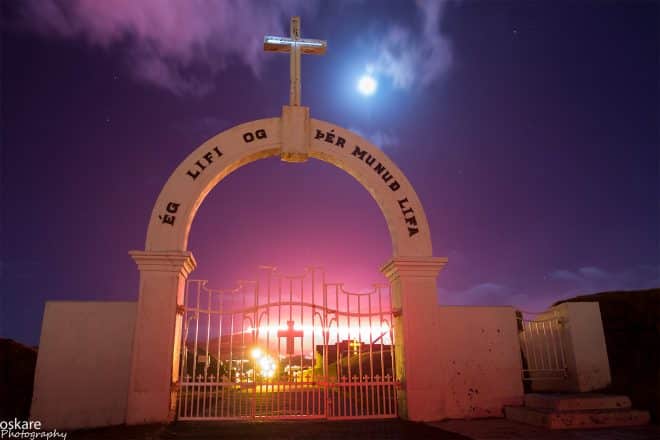
To avoid this catastrophe, 200 rescue workers targeted the encroaching edge of the lava flow. Using hoses, they continuously blasted 100 litres of seawater per second in an attempt to halt the fiery cascade.
Amazingly, this tactic paid off. With help from the US Army, more power was put into this cooling method, and around 1200 litres of water was eventually blasted at the lava per second.
Thankfully, the harbour was saved as well as a large part of the town. The eruption lasted over five months, from January 23rd till July 3rd.
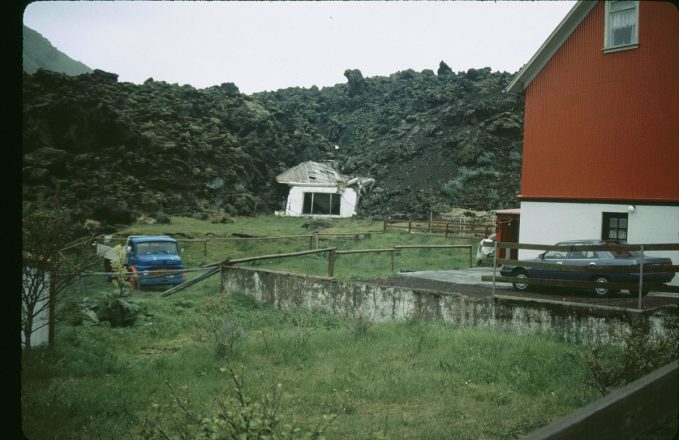
Still today, you can feel the heat emanating from the grounds around Eldfell. Locals often use the mountain’s slopes for baking bread, placing dough in metal containers, then burying them in a hole there overnight.
On your way to hiking Eldfell, you’ll pass through the lava field which destroyed many homes during the 1973 eruption. On top of that, you’ll also see the iconic church that was miraculously saved from the lava flow.
The 200-metre (656 ft) hike to the top of Eldfell takes between 20-30 minutes. The views from the top are spectacular, with sights that encompass the adjacent mountains, the town below and the neighbouring volcano, Helgafell.
On a clear day, you can even see the famous stratovolcano, Eyjafjallajökull, which erupted more recently in 2010.
2. Visit Eldheimar Museum
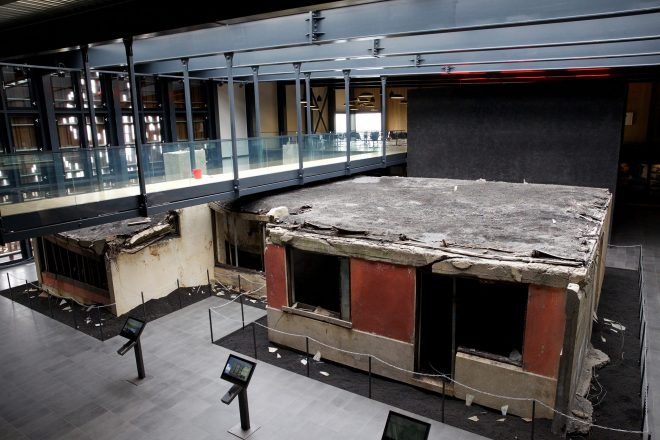
For those of you with a particular interest in the 1973 eruption at Heimaey, look no further than Eldheimar Museum.
Here, you’ll learn about the impact the eruption had on the islanders’ lives. By the end of its five-month eruption, over 400 homes were destroyed, leading to a long reconstruction effort that has finally resulted in the town we see today.
The museum itself was built around the remains of a house at Gerðisbraut 10 street, which was, at the time, home to a family of five. Fortunately today, the ash and lava have been cleaned away from the property, though its history certainly lends authenticity to your visit.
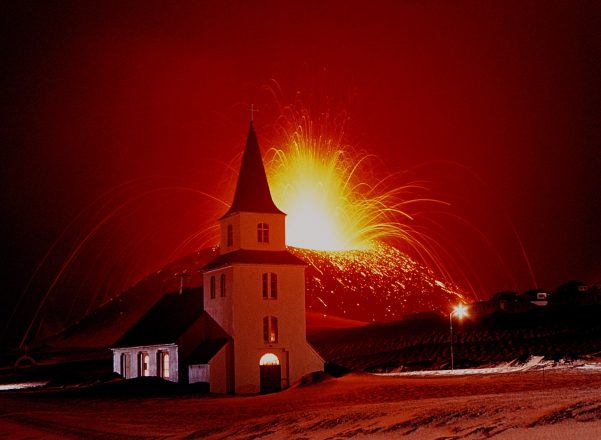
A quick look around the museum and you’ll find a series of photographs and videos captured during the eruption. You’ll also gain insight into how quick thinking the local rescue workers were in saving the island’s precious harbour.
In short, Eldheimar Museum is a fascinating cultural stop to experience either before or after you trek up Eldfell volcano. Ticket prices for adults are 2,600 ISK, and children under the age of ten can enter freely.
The Eldheimar Museum is open every day from 11 AM to 5 PM.
3. Visit the Beluga Whale Sanctuary
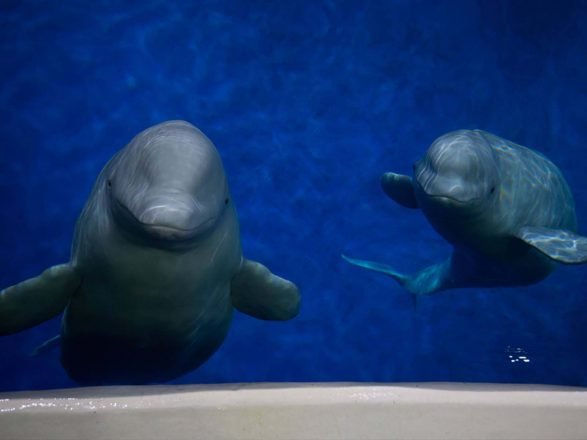
In May 2019, two female beluga whales named Little Grey and Little White were transported from China to Klettsvík bay as part of an international rescue effort led by conservationists.
The whales were captured at a young age from Russian waters and taken to Shanghai’s Changfeng Ocean World Zoo. Once there in captivity, they were forced to perform and were confined at all times in small tanks.
After being in captivity for so long, both whales need to be taught how to behave like wild belugas before being released from the sanctuary’s care pools, including learning to hold their breath for longer durations and introducing them to other creatures such as crabs and shellfish.
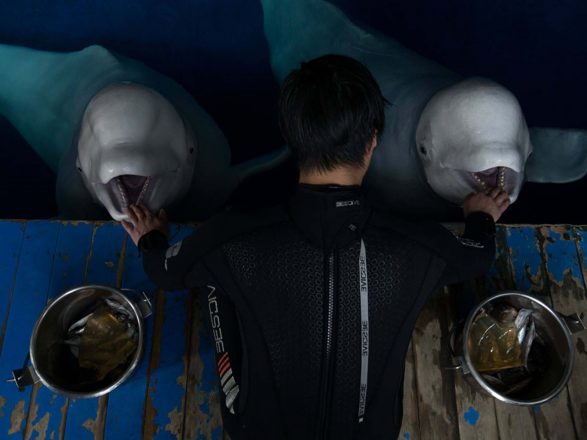
This is where the world’s first beluga whale sanctuary comes into play; a natural bay to rehabilitate Little Grey and Little White, providing them with a safe and natural home.
Heimaey was chosen as the sanctuary’s location by the Sealife Trust due to its rich marine life and cold waters, both of which resemble the native Arctic habitat of beluga whales.
- See whales in the wild on a Whale Watching Tour
This is not Iceland’s first attempt at freeing a whale from captivity. In 1998, Keiko—the star killer whale from the film Free Willy—was brought to the Westman Islands for rehabilitation. After five years of acclimation, Keiko was set free, though later struggled to deal with life in the wild.
The entrance fee to the Sealife Centre is 2,000 ISK. All money raised from admission tickets go to help provide care for Little White and Little Grey, as well as the onsite Puffin Rescue Centre. Given these facts, Heimaey’s Beluga Whale Sanctuary is a great stop for the whole family to enjoy.
The Visitor Centre is open Monday through Saturday from 10 AM to 5 PM, and on Sundays from 1 to 5 PM.
4. Watch Puffins at Stórhöfði Cape
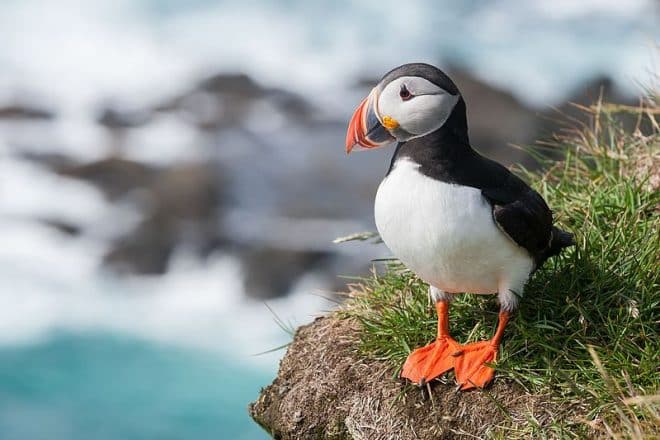
Iceland’s largest puffin colony can be found on the Westman Islands. This is hardly surprising given that the country is home to around 60% of the world’s Atlantic puffins population during the summer months.
One of the best places to see puffins in Iceland is at Stórhöfði Cape, the southernmost point of Heimaey Island.
Stórhöfði cape is about 10 minutes’ drive from town, but it is also possible to hike there. This latter option will take between 45-60 minutes, depending on your pace (—that is, unless friendly locals offer you a ride).
5-minutes’ walk from Stórhöfði car park is a scenic viewing platform. Here, you can take position with your camera or binoculars, watching the Puffins as they swoop from their cliffside nests down to the sea to catch fish.
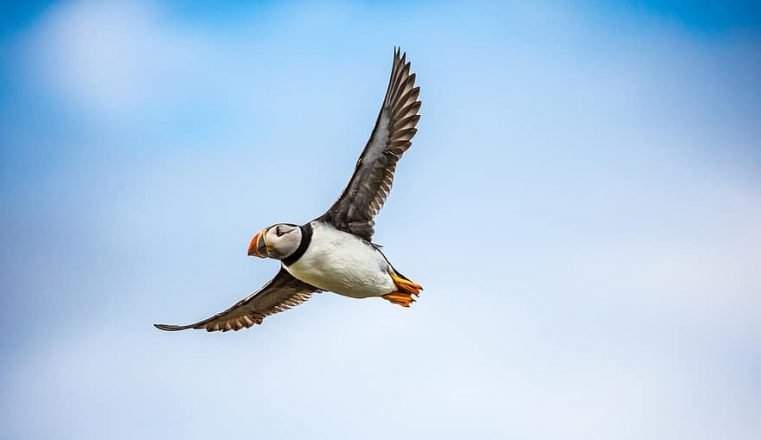
Atlantic Puffins spend their winters out on the ocean, returning to shore to nest in the summers. The first birds are usually spotted mid-April, but by early May, almost all of the puffins have returned to their migratory home.
When the Midnight Sun begins to fade in August, baby puffins—known as Pufflings—start to make their way out to sea. However, since their nesting area in the Westman Islands is close to town, many birds get confused by the street lights and end up heading the wrong direction.
- Learn more about the Midnight Sun in Iceland here
Given this fact, there is a sweet tradition amongst the children of Westman Iceland where they go searching for lost puffins to help them on their way.

Throughout September, puffins will leave their nests in Iceland for the upcoming winter. By the end of the month, all but the stragglers will be gone.
Those planning on visiting Stórhöfði Cape should make sure to wear warm clothes as this spot is considered to be one of the windiest places in Iceland (—some say the whole of Europe!).
5. Dress as a Pirate at Sagnheimar Folk Museum
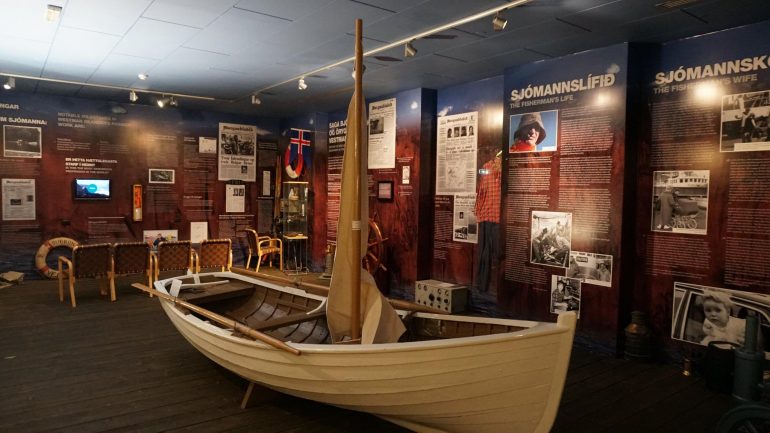
The Sagnheimar Folk Museum might be small, but it encompasses the rich history of the Westman Islands and its people; from the 9th Century Viking settlers to the local dentist who coached Iceland’s football team in the 2018 World Cup.
Here, you can learn about one of the most significant events in Icelandic history; the 1627 raid of Ottoman pirates on Heimaey, or the ‘Turkish Abductions‘.
In July of 1627 pirates from Algier raided settlements on the Reykjanes Peninsula and in East Iceland, abducting and killing many.
News of the raids had reached the Westman Islands, and so when three of the pirate ships were spotted heading towards the town, panic swept across the island.

The locals prepared themselves by arming the harbour with cannons. However, the pirates sailed past the dock and landed on the southern shores where the island inhabitants were defenceless.
The raid lasted for a full three days. The pirates killed 36 people and captured a further 242 which were to be sold as slaves in North Africa.
Sagnheimar Museum makes for the perfect place to learn more about this time of horror, as well as more about the Westman Islands fascinating history. While the adults read about heroism and ship rescues, the children can dress in pirate costumes and search for hidden treasure.
The Sagnheimar Folk Museum is open every day from 10 AM to 5 PM.
6. Celebrate at Þjóðhátíð Festival
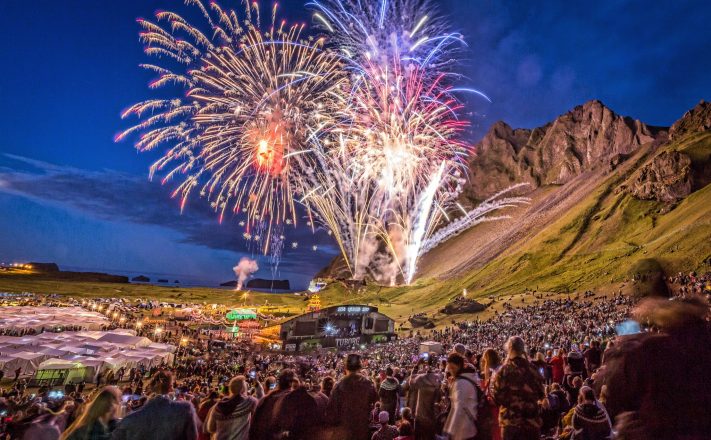
The first Monday in August is a public holiday in Iceland, meaning that the weekend preceding is perfect for travelling and partying.
Towns around the country hold their own festivals in celebration of this weekend which is known as Verlsunarmannahelgin or Commerce Day Weekend.
By far the largest of these festivals is the National Festival, Þjóðhátíð, on Heimaey Island.
- Read about the 14 Best Things to See and Do in Iceland
The main stage is held in the base of a circular amphitheatre of surrounding mountains, known as Herjólfsdalur or simply ‘The Valley’ (Dalurinn).
Locals flock to the festival and campsite fills as guests arrive on the island for four days of various events. These include concerts, bonfire, firework displays, and Sunday night crowd singing.
The music comes second to the enchanted atmosphere at Þjóðhátíð. The biggest event is the Sunday night crowd song when over 10,000 people fill up The Valley.
The nights have gotten dark in August, and nothing save from the main stage is lit up. Then, when the singing starts, thousands of red flairs are lit up, creating a dramatic artificial wall of fire.
The festival was first held in 1874 when islanders couldn’t get to the mainland, due to bad weather, to celebrate the 1000th anniversary of settlement in Iceland.
The festival has been held almost every year since 1901. It was cancelled only in 1914 and 1915 because of World War One and then again this year due to COVID-19.
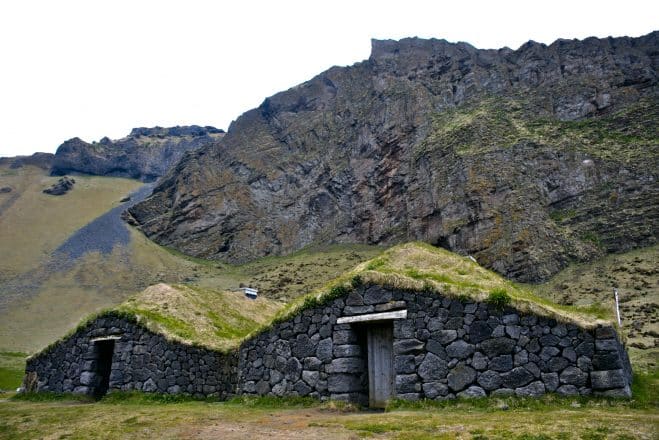
Alternatively, even if you’re visiting Herjólfsdalur at any other time of year, it’s an incredible sight to behold. Here, you’ll find two replica turf houses in which travellers can enter, explore, and imagine the lives of the early Icelanders.
7. Take a Boat Tour to See Surtsey Island & Elephant Rock
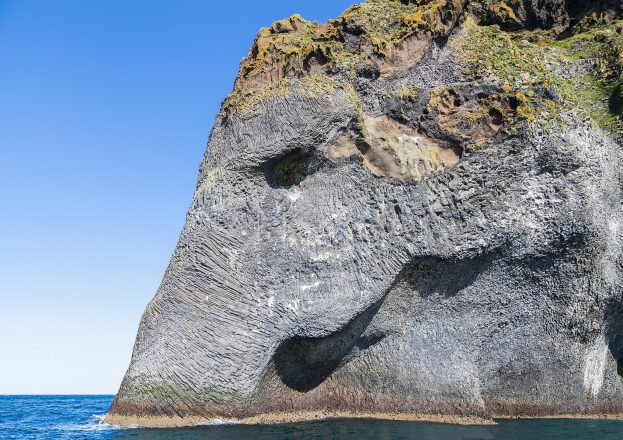
As previously stated, Vestmannaeyjar is an archipelago, meaning there are plenty more islands to discover other than just Heimaey. One surefire means of doing this—save for a private helicopter ride over the bay—is to take a scenic boat tour, most of which depart from Heimaey harbour.
One you can visit is Surtsey, the newest addition to the Westman Islands. Though you cannot step on the island itself due to its fragile biodiversity, the story of Surtsey’s formation has long been of interest to both scientists and nature enthusiasts.
On November 14, 1963 the cook of the trawler vessel Ísleifur II spotted a plume of smoke rising from the sea. Having suspected this was another boat that had caught fire, the captain decided to steer his trawler closer to investigate the situation.
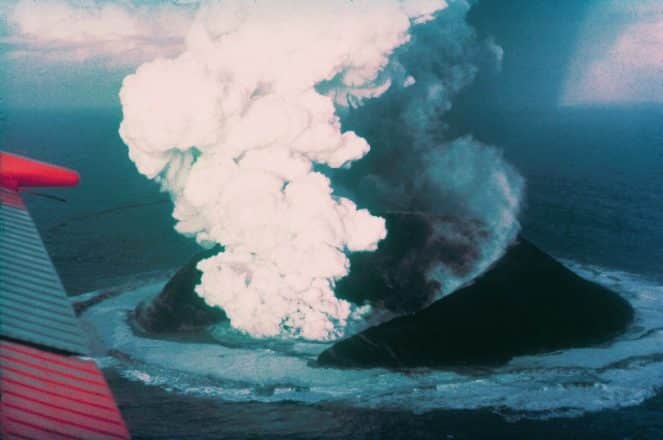
Little did he and his crew know that the smoke had actually been caused by a massive underwater eruption; pillars of volcanic ash were spurting from the water high into the air, forming a new land mass right before their eyes.
The eruption continued for just under four years, until June 1967, by which time the island had grown to be over 500 metres in length and 45 metres high above ocean level.
In the years since, Surtsey has offered scientists and volcanologists valuable insights vital to their research, be it in the field of biology or geology. Given its contribution to our knowledge of how life begins on new volcanic islands, Surtsey was declared a UNESCO World Heritage Site in 2008.
If you are looking to get a clearer understanding of why Iceland is known as the land of fire and ice, make sure to take a boat trip from Heimeay to Surtsey. The island’s explosive past proves it clear as day
Another fascinating rock formation you can see on a boat trip is Elephant Rock. Once little regarded by visitors, this novel point of interest shot to worldwide fame after receiving thousands of views on social media .
As expected, this natural protrusion from a coastal cliffside looks just like Dumbo the elephant, with clear eyes, ears, and a massive trunk that dips into the Atlantic below.
Appreciating Elephant Rock, one can’t help but think Mother Nature must have had a sense of humour when forming Iceland. Make sure not to miss out on the opportunity to get your own snap of this fascinating consequence of Icelandic geology.
8. Go Golfing in a Volcano
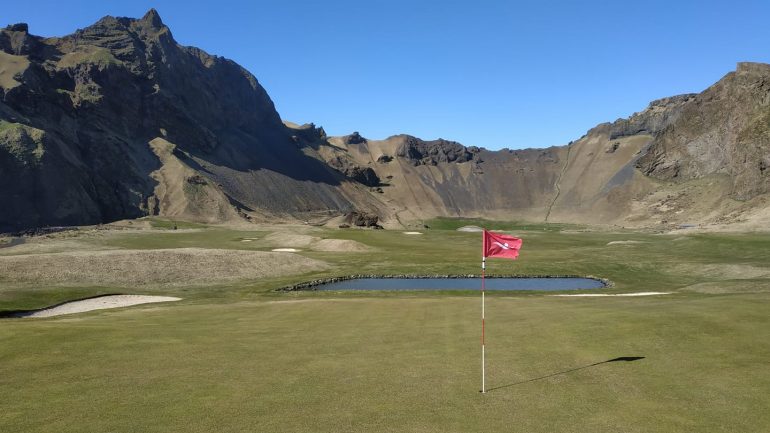
If golfing is your hobby of choice, and more importantly, the weather is okay, make sure you spare some time to have a quick round at Heimaey golf course.
Though it’s a bizarre fact given the climate, there are plenty of golf courses dotted all across Iceland, with the sport being extremely popular among Icelanders.
The par-70 course on Heimaey is located just along the road from Herjólfsdalur, situated dramatically amongst the rock formations of an old volcano. Given that fact, it should come as no surprise that the international Volcano Open Golf Championship is held here every year.
Heimaey’s golf course makes for an incredibly scenic spot to play a round or two. The cliff edges, elephant rock and the neighbouring mountains all make for awe-inspiring surroundings when putting your hole-in-ones.
Keep in mind when playing that the wind from the Atlantic Ocean will play a factor, making the course a more demanding track than the scorecard indicates.
The mild climate in the Westman Islands during the winter makes it even possible to play the whole year. Before arriving, make sure to book a slot at the clubhouse.
9. Hike Heimaklettur Mountain
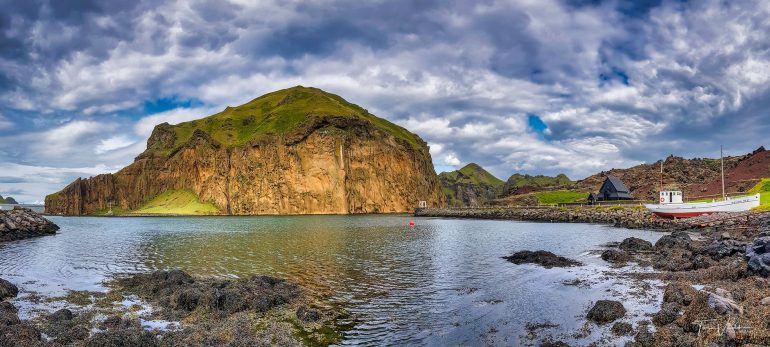
Heimaklettur is the highest mountain in the Westman Islands at 283 metres (928 ft) tall. From the top, you’ll have a fantastic view over the town, the harbour, the surrounding islands, and the glaciers Eyjafjallajökull and Mýrdalsjökull on the mainland.
The hike is short, between 30 minutes to an hour, but can be a little bit intense as the path up the mountain can be steep.
The route starts behind the trailhead sign, and the path will lead you to a wooden ladder which will help you get past the first cliff band.
Throughout the trail, you’ll find more of these ladders, all at an angle of around 70 degrees. This means that they are not too steep to be strenuous but definitely a bit scary for those afraid of heights.
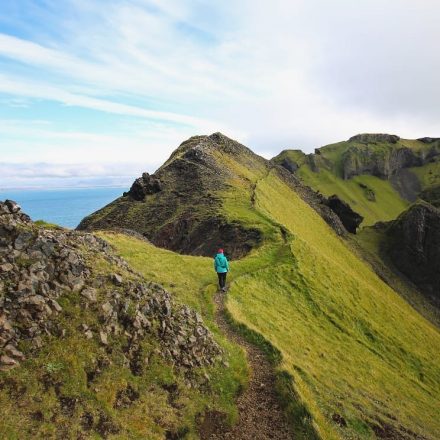
You’ll follow a trail which zigzags up the steep hillside. Ropes and chains have been placed in places where the path narrows, to help you ascend. You will then reach a dramatic ridge which you can follow to the summit.
The route should only be taken in good conditions. Although the hike is never perilous, it might feel that way to some.
At the top, you’ll get a fantastic view of the volcano Eldfell and the lava field which almost destroyed the harbour in 1973.
10. Visit the Brothers Brewery

The Brothers Brewery is the lovechild of four Westman Islands’ locals, all of whom share an enduring passion for creating delicious beers.
For those partaking in a brewery tour, there is a fine selection of tasters on offer, each of which offers a different flavour that could be considered authentic to the Westman Islands.
These include the likes of Eldfell (6% Red Ale), named after the island’s infamous volcano, and a beer known as 23.01.73 (6% Cascadian Dark Ale) named after the date of its eruption.
Aside from that, you’ll also get a close-up view of the brewing process in action, watching as wheat, hops and other secret ingredients are blended to create Brothers’ Brewery’s fine variety of products.
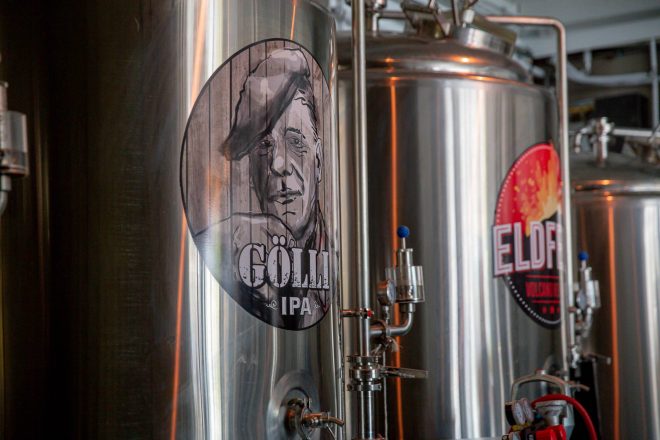
Of course, the brewery contributes to the island life in more ways than just keeping its bars and restaurants stocked with booze. Every June, for instance, the Brothers Brewery hosts the Street Food and Beer Festival, adding a day of festive drinking and dining to Heimaey’s social calendar.
Brothers Brewery is located right next door to the new Beluga Sanctuary and is open every day during the summers and on Thursdays, Fridays and Saturdays during the winter months.
11. Spring from a Cliff on Sprangan Cliff Swing
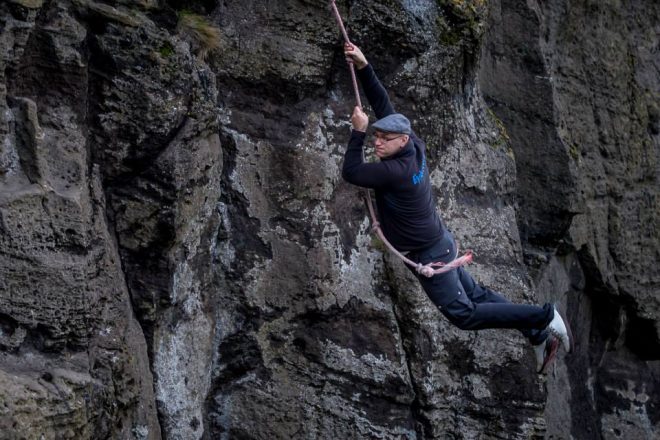
Residents of Heimaey like to participate in a unique and exhilarating tradition that sees them swinging from ropes along the island’s coastal cliff sides.
This is known as Sprangan, and comes highly recommended for any traveller looking for a taste of the action when travelling in the Westman Islands.
Sprangan is the Westman Islands’ unofficial national sport. According to Westman Island lingo, “sprang” means to kick yourself from a cliff while holding onto a rope.
The cliff and rope is found above a network of well-known caves named Skiphellar (Ship Caves), only adding to the pirate-like behaviour of Heimaey’s locals.
The lowest ledge rests at only three metres above the ground, making it perfect for beginners looking to try their hand at the sport. For those who quickly get the knack of it, higher platforms up the cliffside are sure to add a further level of adrenaline to the experience.
Be warned, however; Sprangan can be dangerous for those without the expertise, so always make sure to try the activity first under the watchful eye of an experienced local.
How to Get to the Westman Islands

The Westman Islands are accessible by bus, car, boat and plane. All but the plane option will require a short ferry journey from Landeyjahöfn on Iceland’s South Coast.
Which way you choose to reach the Westman islands depends on a number of factors, mostly your budget, time restrictions, and whether or not you have rented a car.
The Ferry to Westman Islands
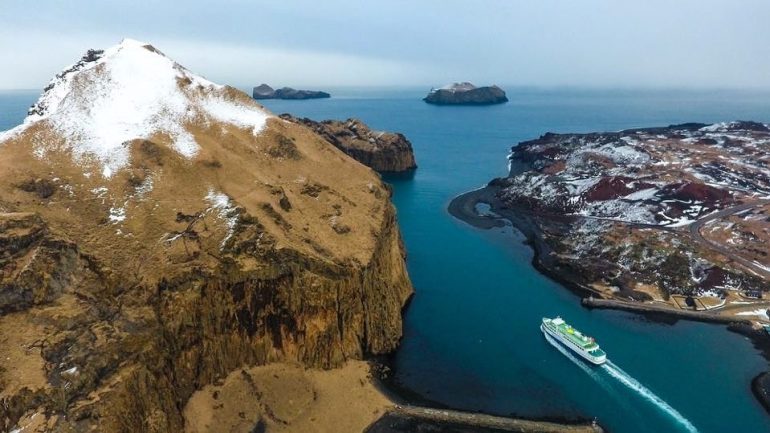
Those planning on not flying to the Westman Islands will need to get to Landeyjarhöfn harbour in southwest Iceland to catch the ferry (which is called Herjólfur).
The ferry ride between Landeyjarhöfn on mainland Iceland and the Westman Islands takes approximately 35-40 minutes.
On rare occasions, conditions at Landeyjarhöfn become unsuitable for Herjólfur to dock. The ferry will instead arrive at the harbour in Þorlákshöfn town. In those cases, the journey from the Westman Islands will take around 2 hours and 45 minutes.
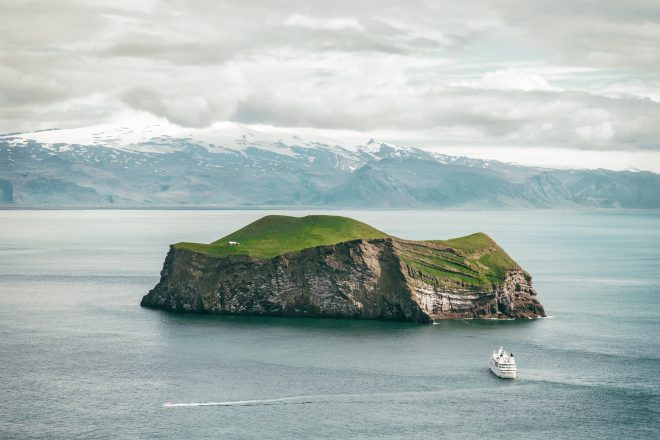
Your ticket will still be valid if this happens, and the ferry company will message ticket holders to let them know of this change.
That is why booking a ticket on Herjólfur in advance is recommended. It is also necessary if you are planning to bring your car over or are visiting for the Þjóðhátíð festival.
A standard adult return ticket is 1,600 ISK, 800 ISK for teenagers aged 12-15, but free for those younger than 12.
Travel to the Westman Islands by Car
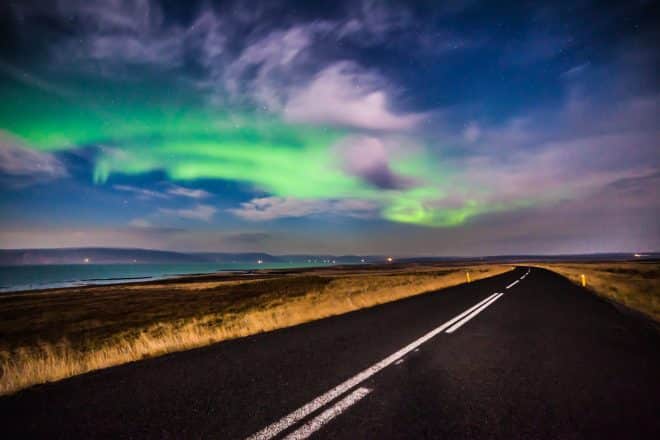
A visit to the Westman Islands can be an ideal addition for those on a self-drive tour (–just let us know if you want to add it to your excursion).
It takes a little less than an hour to drive to Landeyjarhöfn from Reykjavík, and about an hour from Selfoss town.
- Browse our selection of Self-Drive Tours or Tailor-Make your very own
After arriving at Landeyjarhöfn, you can either park your car at the free parking lot or bring it along on the ferry.
A car on Heimaey Island allows you to explore more in less time. However, it will be an additional 2,300 ISK for a normal-sized car in addition to the 1,600 ISK return ticket.
Walking around the Westman Islands in the summer is fantastic, and the majority of attractions are found within a 5-25 minutes walking distance of the harbour.
Travel to the Westman Islands by Bus
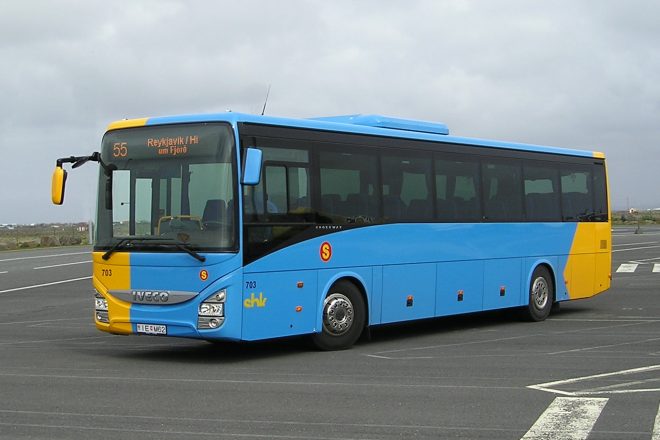
Those looking to stay on a budget can take a bus to Landeyjarhöfn.
The bus departs from Reykjavík, from the bus station Mjódd in one of the city’s suburbs. If you are staying in downtown Reykjavík, you need to take another bus to get to Mjódd.
- Discover Iceland on a Small-Group Guided Tour
Bus Route 52 travels from Reykjavík to Landeyjarhöfn harbour, with stops at Hveragerði, Selfoss, Hella, and Hvolsvöllur towns.
Currently, there are two departure times from Mjódd, the first one at 8 AM and the second one at 5:45 PM. However, we urge you to check for yourself at straeto.is in case there have been any changes.
According to their timetable, the bus journey from Reykjavík to Landeyjarhöfn takes just over 2 hours.
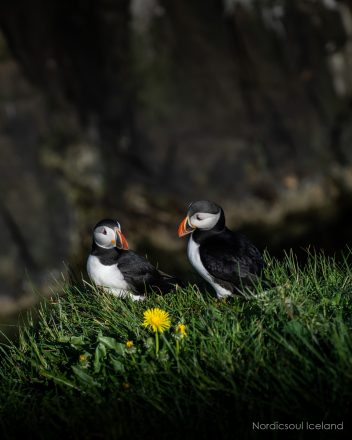
In cases where the ferry docks at Þorlákshöfn, Route 52’s final stop will be Hvolsvöllur and another bus marked “Herjólfur” will transport passengers to Þorlákshöfn.
If the ferry from Heimaey docks at Þorlákshöfn, a bus will be waiting onsite. It will depart to Reykjavík once all passengers have disembarked.
A one-way ticket from Mjódd to Þorlákshöfn costs 4,800 ISK for an adult, 1,670 ISK for 12-17 year olds, and 730 for children aged 6-11. Unlike the city buses, you can pay with a credit or a debit card in country buses. It is not possible to book a seat in advance.
Travel to the Westman Islands by Plane
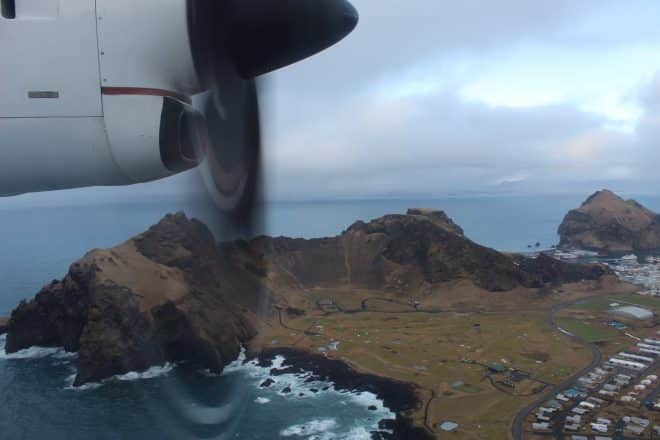
For those of you staying in Reykjavík and are short on time, keen to see the Westman Islands in a unique way, and don’t mind spending a little extra cash, there is the option of taking a plane to the archipelago.
The 30-minute flight from Reykjavík’s domestic airport takes you on a small passenger plane over the city and the beautiful South Coast, before reaching the airport on Heimaey.
- Explore Iceland from above on a Helicopter Tour
Departure times and prices vary depending on which day you are booking. Flying is by far the most expensive way to get to the Westman Islands but also the quickest route and requires the least hassle.
Most flights will depart early in the morning, and passengers are recommended to arrive at Reykjavík Domestic Airport 60 minutes prior to departure. Those in a wheelchair or need any special assistance are advised to contact the airline, Eagle Air, beforehand to ensure a smooth service.
Where to Stay and Where to Eat on the Westman Islands
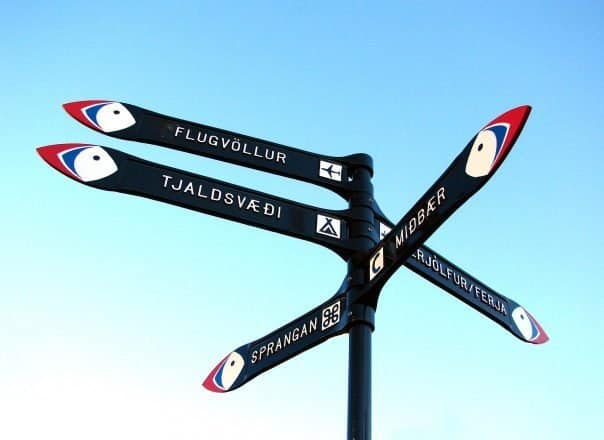
If you are looking to spend a night or two (or more) on the Westman Islands, you’ll have plenty of options.
Here, you’ll find hotels, hostels, cottages, and apartments. There is also a campsite which is very popular with festival-goers during the Þjóðhátíð festival.
Those looking to stay on the Westman Islands can contact us at Traveo, and we can find the best place for you within your budget.
There are also a multitude of restaurants on Heimaey Island. The highest rated one is Gott, a family-owned restaurant with an emphasis on fresh, local ingredients.

Other notable stops include Slippurinn, which specialises in traditional food but with a twist, and Einsi Kaldi, the place to go if you are craving a lava cake (–and Westman Islands is the perfect place to enjoy such a delicacy).
Those on a budget can find a Krónan discount grocery store in town, as well as many smaller shops and stores.
In Summary of the Westman Islands
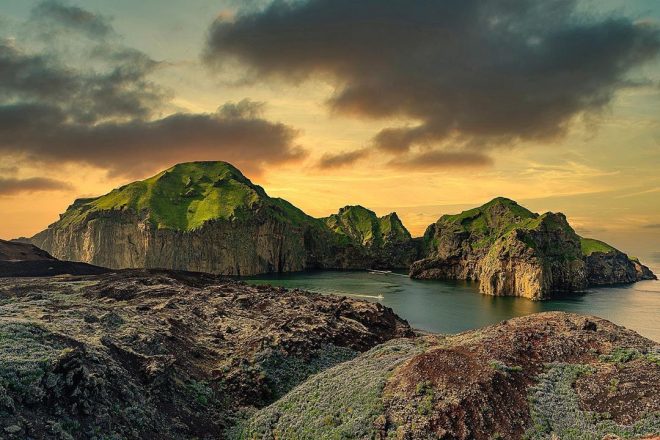
In summary, the Westman Islands are an overlooked gem; an archipelago rich in nature, wildlife, history.
Most travellers will visit Heimaey during the summer to get a glimpse of the beautiful Atlantic Puffins that nest on its cliffsides, or attend the Þjóðhátíð festival.
On the other hand, those who visit the Westman Islands in the winter will find it a beautiful getaway; a perfect and isolated spot to hunt for the magical Northern Lights.
We hope you found this list of the top 11 things to do on the Westman Island helpful, and it has given you some insight as to what to see and do for your upcoming trip. We’d love to hear from you in the comments section below if you have any questions, memories or top tips you’d like to share.

